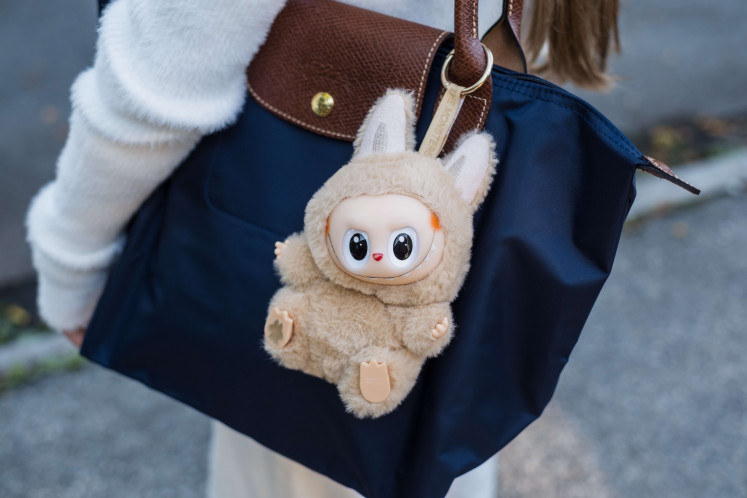Popular Reads
Top Results
Can't find what you're looking for?
View all search resultsPopular Reads
Top Results
Can't find what you're looking for?
View all search results'Discourse of the Past' Titarubi's take on history
Withering past: A visitor stands in front of Something Remains at Philo Art Space, Jakarta
Change text size
Gift Premium Articles
to Anyone
Withering past: A visitor stands in front of Something Remains at Philo Art Space, Jakarta. (JP/Jerry Adiguna)
After a long time away, acclaimed artist Titarubi is back with a solo exhibition on home soil with 'Discourse of the Past', an investigation into Indonesia's past.
Titarubi, whose work has been collected and exhibited throughout Asia and Europe, displayed five pieces in the exhibition, including sculptures, installations and a drawing series.
'Discourse of the Past' is exhibited at Philo Art Space gallery in South Jakarta until April 18.
The 45-year-old said the exhibition had been planned for two years, but a technical problem with one of her pieces kept on postponing it.
'The idea for the exhibition comes from consideration that it has been a long time since I held a solo exhibition in Indonesia,' Titarubi told The Jakarta Post.
Another consideration was because Philo Art Space was owned by noted philosopher Tommy F. Awuy, who is curating the exhibition.
'With Tommy's philosophy background, I was hoping to attain a more specific, deeper perspective when we discussed the art.
'I need to be able to see with a different point of view or way of thinking with what I've been having until now,' Titarubi said.
She said that the solo exhibition was a venture into Indonesia's glorious but forgotten wealth and history, a main thread that pulled together the sculpture of thousands of nutmegs in the sculpture titled Hallucinogenic.
Hallucinogenic presents a mysterious mystic shrouded in thousands of gold plated nutmegs, holding a gold plated book and a tree branch staff with charred hands.
The shrouded mystic previously appeared in Titarubi's 2013 work Imago Mundi, which was displayed among other artwork upon invitation by Museum Van Loon in the Netherlands in an exhibition intended to reflect upon the role the Van Loon family had in the Dutch East India Company ' also known as VOC.
In the sculpture, Titarubi made a large robe made of metal and gold plated nutmeg. Nutmeg is a spice that comes from the Banda Islands in Maluku.
Titarubi said that in the 16th and 17th centuries, nutmeg was the most desired luxury good in Europe ' more valuable than gold ' and attracted Europeans to the Nusantara archipelago.
The English and the Dutch engaged in prolonged battles to gain control of nutmeg. Then VOC governor-general, Jan Pieterszoon Coen, waged a bloody war to enforce a Dutch monopoly on the Banda's spice trade, including the massacre and enslavement of the inhabitants of the islands in 1621.
After the killings, the Banda Islands were run as a series of plantation estates with imported slaves from Java and other Indonesian islands. The price of nutmeg was kept artificially high by the Dutch, intentionally burning full warehouses of nutmegs in Amsterdam.
It was during her research into Indonesian spice history that Titarubi discovered the story of Keumalahayati, a 16th century female admiral of the navy of the Aceh Sultanate. Keumalahayati's powerful navy helped the sultanate become strong and control merchant shipping routes in the Malacca Strait.
'Keumalahayati commanded great ships, but it is difficult to find a reference or document about what the ships looked like,' Titarubi said
Her work in Something Remains, which is made of burned wood, reflects this piece of lost history. 'Once we had the perfect ship, but now we no longer have it,' Titarubi said.
Curator Tommy said that through her work, Titarubi revealed a chain of events in one of the most important periods in Indonesian history, which was part of a massive effort to look into the past.
'History is often interpreted by those with specific and scientific backgrounds. It would be quite a surprise if another party outside did their own interpretation of history,' said Tommy, who teaches at the University of Indonesia (UI) and the Jakarta Arts Institute (IKJ).
Tommy said Titarubi was building a narration on her focus on the history of Indonesian spice, by connecting one element to another to create a flowing and complete story.
'I hope Titarubi's historical narration through visual presentation can fulfill our curiosity, despite being one story among many other larger stories about the past. Narration can always return to the main actor: human; as the subject, witness, and more importantly, victim,' he said.











